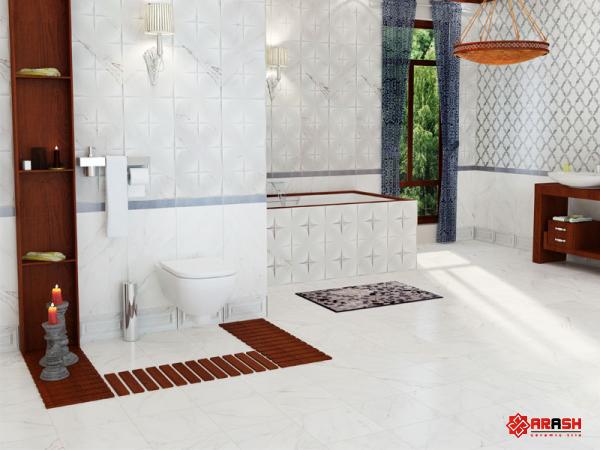When it comes to selecting the right tile for your home or business, two popular options frequently come to mind: ceramic and porcelain. Both these materials have their own unique characteristics, and understanding their differences is crucial to making an informed choice. In this article, we will explore the features, benefits, and considerations of ceramic tile versus porcelain tile, helping you decide which is best suited for your needs. 1. Definition and Production: Ceramic Tile: Ceramic tiles are composed of clay and other natural materials, molded and kiln-fired to create a hardened product. The clay base is topped with a decorative glaze for color and texture. Porcelain Tile: Porcelain tiles are made from a finer blend of clay and a higher percentage of feldspar minerals, finely ground and then exposed to higher pressures and temperatures compared to ceramic tiles.

.
 This process results in a denser and less porous final product. 2. Durability and Resistance: Ceramic Tile: Ceramic tiles have been used for centuries and remain a popular choice due to their durability. They are resistant to scratches and wear, making them suitable for both residential and light commercial areas. However, they are more porous than porcelain tiles, making them more prone to staining and absorbing water. Porcelain Tile: Porcelain tiles are extremely durable and highly resistant to heavy foot traffic, making them ideal for high-traffic areas and commercial applications. Their low water absorption rate makes them frost-proof, making them suitable for both indoor and outdoor use. Porcelain tiles are also highly scratch-resistant and less likely to fade or stain. 3. Design Options: Ceramic Tile: Ceramic tiles offer an extensive selection of colors, patterns, and decorative designs. From traditional to contemporary styles, ceramic tiles can cater to diverse aesthetic preferences. The glaze applied to the surface enhances the tile’s appearance, making it more vibrant and glossy.
This process results in a denser and less porous final product. 2. Durability and Resistance: Ceramic Tile: Ceramic tiles have been used for centuries and remain a popular choice due to their durability. They are resistant to scratches and wear, making them suitable for both residential and light commercial areas. However, they are more porous than porcelain tiles, making them more prone to staining and absorbing water. Porcelain Tile: Porcelain tiles are extremely durable and highly resistant to heavy foot traffic, making them ideal for high-traffic areas and commercial applications. Their low water absorption rate makes them frost-proof, making them suitable for both indoor and outdoor use. Porcelain tiles are also highly scratch-resistant and less likely to fade or stain. 3. Design Options: Ceramic Tile: Ceramic tiles offer an extensive selection of colors, patterns, and decorative designs. From traditional to contemporary styles, ceramic tiles can cater to diverse aesthetic preferences. The glaze applied to the surface enhances the tile’s appearance, making it more vibrant and glossy.
..
 Porcelain Tile: Porcelain tiles come in a wide range of designs, including options that convincingly mimic natural stone, concrete, or wood. Advanced printing technology enables manufacturers to create patterns with incredible detail and variation. Porcelain tiles also offer a matte or polished finish, giving greater flexibility in achieving desired aesthetics. 4. Maintenance and Cost: Ceramic Tile: Ceramic tiles are relatively easy to clean and maintain. Regular sweeping and damp mopping are usually sufficient to keep them looking good. However, due to their slightly porous nature, grout lines may require occasional sealing to prevent staining. Additionally, ceramic tiles are generally more affordable compared to porcelain tiles, making them a cost-effective option for budget-conscious projects.
Porcelain Tile: Porcelain tiles come in a wide range of designs, including options that convincingly mimic natural stone, concrete, or wood. Advanced printing technology enables manufacturers to create patterns with incredible detail and variation. Porcelain tiles also offer a matte or polished finish, giving greater flexibility in achieving desired aesthetics. 4. Maintenance and Cost: Ceramic Tile: Ceramic tiles are relatively easy to clean and maintain. Regular sweeping and damp mopping are usually sufficient to keep them looking good. However, due to their slightly porous nature, grout lines may require occasional sealing to prevent staining. Additionally, ceramic tiles are generally more affordable compared to porcelain tiles, making them a cost-effective option for budget-conscious projects.
…
 Porcelain Tile: Porcelain tiles require minimal maintenance and are easy to clean, usually requiring only regular sweeping and mopping. The low porosity of porcelain tiles means they are less prone to staining or absorbing dirt and allergens. As for cost, porcelain tiles tend to be costlier than ceramic tiles due to the manufacturing process and their superior durability. Conclusion: The decision between ceramic and porcelain tiles ultimately depends on your specific needs and priorities. Ceramic tiles are a durable and budget-friendly option, with a wide array of design choices. Porcelain tiles, on the other hand, offer enhanced durability, water resistance, and a luxurious finish while costing slightly more. Consider factors like foot traffic, aesthetics, and long-term maintenance when making your choice. Whichever you choose, both ceramic and porcelain tiles provide beautiful and functional solutions for your flooring needs.
Porcelain Tile: Porcelain tiles require minimal maintenance and are easy to clean, usually requiring only regular sweeping and mopping. The low porosity of porcelain tiles means they are less prone to staining or absorbing dirt and allergens. As for cost, porcelain tiles tend to be costlier than ceramic tiles due to the manufacturing process and their superior durability. Conclusion: The decision between ceramic and porcelain tiles ultimately depends on your specific needs and priorities. Ceramic tiles are a durable and budget-friendly option, with a wide array of design choices. Porcelain tiles, on the other hand, offer enhanced durability, water resistance, and a luxurious finish while costing slightly more. Consider factors like foot traffic, aesthetics, and long-term maintenance when making your choice. Whichever you choose, both ceramic and porcelain tiles provide beautiful and functional solutions for your flooring needs.











Your comment submitted.